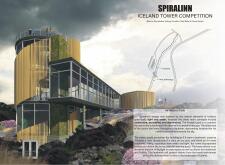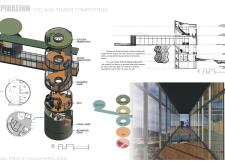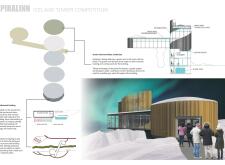5 key facts about this project
Spiralinn is located in the dramatic landscape of Iceland, designed to connect visitors with their surroundings. It functions as a multi-use space that encourages exploration and interaction with the environment. The design focuses on the themes of light and water, creating a structure that allows people to ascend towards the sky or descend into ice caves.
Vertical Movement
The project highlights vertical movement, giving visitors the experience of changing elevations within the building. This upward and downward journey mimics the natural geological formations found in Iceland, resembling the rise of a volcano or the fall into an ice cave. Through this design, Spiralinn strengthens the relationship between the architecture and the landscape.
Fluid Design Forms
The building features smooth, curved forms that reflect the movement of water and the natural shapes of the surrounding environment. These ribbon-like structures blend with the landscape and promote a connection between the built space and nature. Ample natural light pours into the interiors, enriching the experience for those who enter.
Architectural Elements
A key feature of Spiralinn is the glass bridge that crosses the fissure, allowing visitors to traverse safely while enjoying views of the landscape. This design not only serves its purpose as a pathway but also connects different areas of the tower visually. The main tower is positioned within the slope of the fissure, ensuring stability while guiding visitors downward to the ice caves.
Sustainable Integration
Sustainability is a significant aspect of the project. Geothermal heating systems are implemented to reduce energy use in the cold climate of Iceland. This heating ensures a comfortable environment for visitors, particularly during winter months. Additionally, the green roof absorbs rainwater and helps regulate temperature, promoting environmental responsibility.
The interior spaces utilize locally sourced hardwood and basalt stone, enhancing the connection to Iceland's natural landscape. The warm, muted tones create an inviting atmosphere, allowing visitors to appreciate the surroundings as they move through the building.






















































